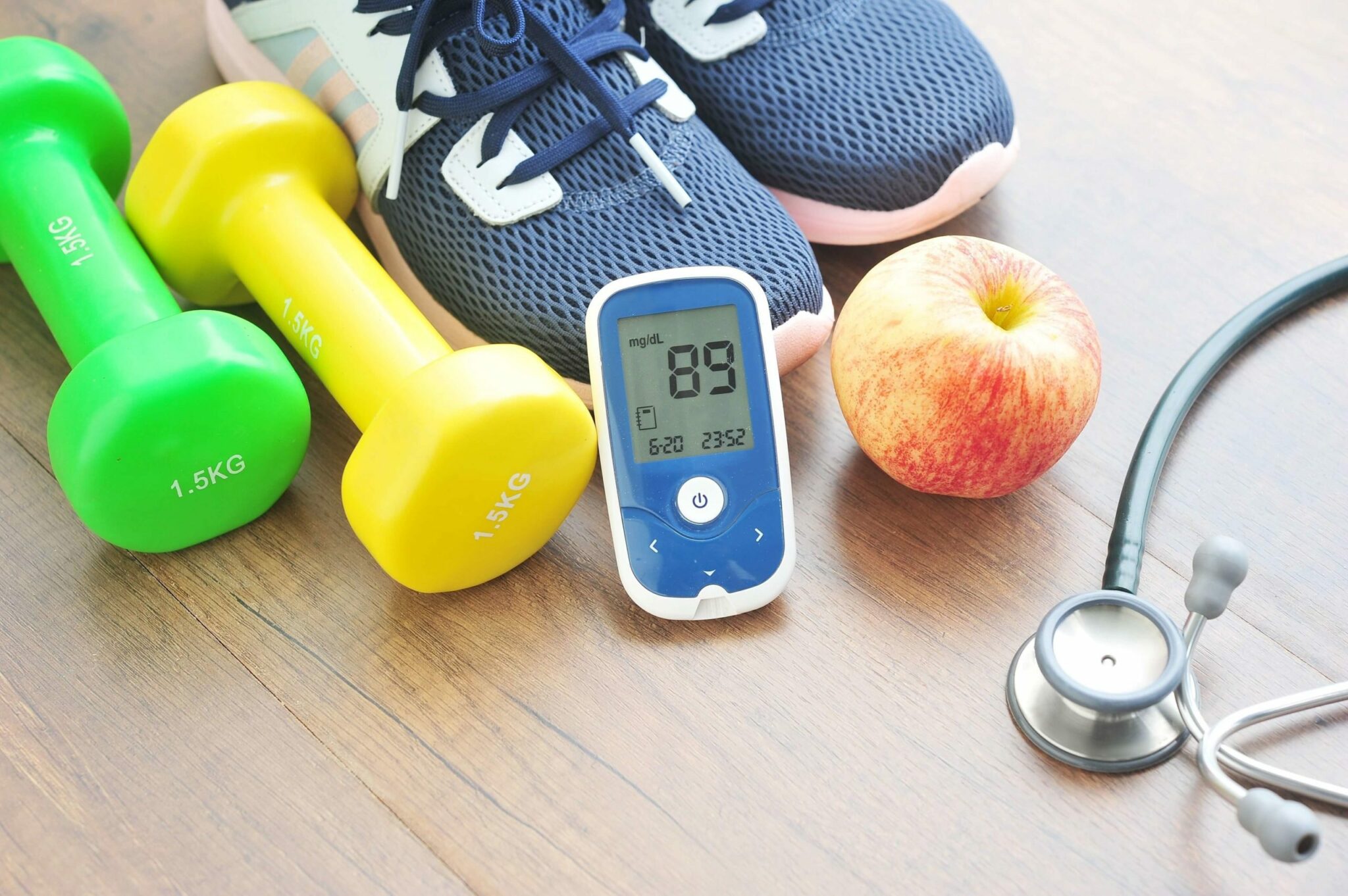I’ve Been Diagnosed With Diabetes. How can Exercise Help Improve my Condition?


Diabetes is not one single condition, there are multiple types that share a common defining feature; an inability of the body to control blood sugar levels. There are three main types of diabetes, type 1, type 2 and gestational diabetes. Risk factors, the average age of onset and treatment approaches may all vary across the different types of diabetes, but one thing that is constant across all forms is the benefit of regular exercise.
Most of the studies that have looked at the benefits of exercise with regards to diabetes management have investigated aerobic and/or resistance training. Aerobic exercise involves repeated, continuous movements utilising the large muscle groups. It is usually moderate to high intensity and is also referred to as cardio training. Resistance training is a means of building up strength. It uses some form of resistance (most commonly, free weights, resistance bands or a person’s own body weight), to induce the muscles to contract. There is some evidence that regular stretching and yoga-type activities can also be beneficial.
Type 1 Diabetes
Type 1 diabetes mellitus (T1DM) is usually diagnosed during childhood. The body is unable to produce insulin so people with the condition require daily injections of insulin to regulate their blood sugar levels. There is currently no cure for T1DM and adopting lifestyle changes, such as regular exercise, will not make the condition go away. However, remaining physically active can improve your overall health.
Regular, moderate exercise has a significant effect on acute and chronic glycaemic control. There have been insufficient studies to determine the optimal type of exercise that will help with T1DM, however, aerobic training has been shown to improve cardiorespiratory fitness and reduce insulin resistance. People with T1DM diabetes are at a higher risk of experiencing hypoglycaemic events; however, brief periods of high intensity exercise can minimise this risk. There is also an overall reduction in mortality rates in those patients who undergo regular physical activity. The data is less well defined with regards to resistance training. Performed in combination with aerobic exercise, it likely has a beneficial effect, but the scientific evidence for it is limited.
Of course, patients with T1DM need to remain aware of their blood sugar levels both before and after exercise. Most beneficial effects are observed when exercise is undertaken in the postprandial period (1-3 hours after consuming a meal). However, if blood sugar levels fall below 100mg/dL or rise above 250mg/dL, additional care is warranted and stabilisation of levels should be obtained before exercise commences.
Type 2 Diabetes
Far more common than the type 1 form of the condition, type 2 diabetes mellitus (T2DM) is diagnosed when the body struggles to produce sufficient insulin, or the cells of the body fail to adequately respond to the hormone. The second of these situations is known as insulin resistance. Risk factors include age, having a high BMI and genetics, with most people being diagnosed in middle age. The rising obesity rates across the developed world are leading to significantly more cases of T2DM. Polycystic Ovary Syndrome (PCOS), which is the most common endocrine condition affecting women of reproductive age, also significantly increases the risk of a female developing T2DM. PCOS is strongly associated with both obesity and insulin resistance, meaning weight loss through exercise can also help to control the symptoms of this condition, as well as reducing the risk of developing T2DM. Whilst medications can help to control the symptoms of T2DM, most doctors also appreciate the value of encouraging their patients to implement lifestyle changes to help manage the condition. It has even been suggested that with significant weight loss, T2DM might be driven into remission.
Performing aerobic exercise, resistance training, or a combination of the two has been shown to have a small to moderate beneficial effect on glucose control. In fact, the benefits are enhanced by taking a combination approach and incorporating both types of exercise into a workout. Experts recommend a minimum of 30 minutes of aerobic exercise each day to improve insulin resistance, and 2-3 sessions of resistance training per week, on non-consecutive days.
Those who are classed as pre-diabetic have blood glucose levels above the normal range and are at high risk of developing T2DM. Studies have shown that those people who fall into this category and undertake 150 minutes of physical activity a week, alongside implementing dietary changes,reduce their risk of T2DM by between 40 and 70%.
Gestational Diabetes
Gestational diabetes (GDM) is usually diagnosed between weeks 24 and 28 of pregnancy. Greater weight gain during pregnancy is associated with an increased risk of GDM, as is leading a sedentary lifestyle. It is normal to be less active when pregnant as natural hormonal changes that occur during pregnancy can affect energy levels, muscle strength and mood. As pregnancy advances, the weight and pressure of the growing uterus and developing baby can also restrict the exercises that a woman feels comfortable doing. However, there is evidence suggesting that undertaking moderate exercise such as walking, yoga or swimming can be beneficial; and that doing so early in pregnancy, can protect against the later development of GDM. GDM can be dangerous for both the mother-to-be and her unborn child, therefore, it is very important to implement preventative measures from early on in a female’s pregnancy. Furthermore, women with GDM are at increased risk of developing T2DM and, thus, longer term lifestyle adjustments should be considered after the gestation period.
Doctors recommend that pregnant females partake in 20-30 minutes of moderate exercise per day. Clearly, not all exercises are appropriate; contact sports and those with a risk of falling should be avoided. However, recreational physical activity is strongly recommended. Aerobic and resistance training can both be performed safely during pregnancy, but participants should avoid prolonged periods of high temperatures, or excessive fluid loss through sweating.
The longer-term benefits of exercise
As shown above, losing weight, through exercise and adapting a well-balanced diet, can improve the day-to-day quality of life for patients with diabetes. It can, however, also have a positive effect on a patient’s future health and reduce their risk of experiencing diabetes-related complications down the line.
Those with diabetes are at increased risk of cardiovascular disease, through mechanisms not yet fully understood. Increased physical activity has been shown to reduce the risk of adverse cardiac events in a number of studies. As a direct result of this, the American Diabetes Association and the Diabetes Prevention Program both advocate the use of exercise as a means of managing and preventing diabetes-induced heart disease.
Conclusion
Exercise has many benefits; it lowers blood glucose levels and increases the body’s sensitivity to insulin, meaning that it can be a very useful tool in the management of diabetes. It is also an effective means of losing weight and a natural mood enhancer and stress reliever; thereby improving quality of life in those with a long-term chronic condition, such as diabetes.
Taking part in regular physical activity improves the health of those with T1DM. It can also be used to prevent, or at least delay, the development of T2DM in those who are considered to be high risk, including those with GDM. The use of exercise as part of the treatment approach for any form of diabetes is widely accepted and encouraged.
Nabta is reshaping women’s healthcare. We support women with their personal health journeys, from everyday wellbeing to the uniquely female experiences of fertility, pregnancy, and menopause.
Get in touch if you have any questions about this article or any aspect of women’s health. We’re here for you.
Sources:
- Colberg, Sheri R., et al. “Physical Activity/Exercise and Diabetes: A Position Statement of the American Diabetes Association.” Diabetes Care, vol. 39, no. 11, Nov. 2016, pp. 2065–2079., doi:10.2337/dc16-1728.
- “Exercising with Gestational Diabetes.” Diabetes.co.uk, 12 Nov. 2019, www.diabetes.co.uk/gestational-diabetes/exercising-with-gestational-diabetes.html.
- Harvard Health Publishing. “The Importance of Exercise When You Have Diabetes.” Harvard Health, https://www.health.harvard.edu/staying-healthy/the-importance-of-exercise-when-you-have-diabetes.
- Helmrich, Susan P., et al. “Physical Activity and Reduced Occurrence of Non-Insulin-Dependent Diabetes Mellitus.” New England Journal of Medicine, vol. 325, no. 3, 18 July 1991, pp. 147–152., doi:10.1056/nejm199107183250302.
- Lew, Jason Kar Sheng, et al. “Exercise Mediated Protection of Diabetic Heart through Modulation of MicroRNA Mediated Molecular Pathways.” Cardiovascular Diabetology, vol. 16, no. 1, 13 Jan. 2017, doi:10.1186/s12933-016-0484-4.
- Mccombie, Louise, et al. “Beating Type 2 Diabetes into Remission.” Bmj, vol. 358, 13 Sept. 2017, doi:10.1136/bmj.j4030.
- Padayachee, Cliantha, and J S Coombes. “Exercise Guidelines for Gestational Diabetes Mellitus.” World Journal of Diabetes, vol. 6, no. 8, 25 July 2015, pp. 1033–1044., doi:10.4239/wjd.v6.i8.1033.
- Snowling, N. J., and W. G. Hopkins. “Effects of Different Modes of Exercise Training on Glucose Control and Risk Factors for Complications in Type 2 Diabetic Patients: A Meta-Analysis.” Diabetes Care, vol. 29, no. 11, Nov. 2006, pp. 2518–2527., doi:10.2337/dc06-1317.
- Tonoli, Cajsa, et al. “Effects of Different Types of Acute and Chronic (Training) Exercise on Glycaemic Control in Type 1 Diabetes Mellitus.” Sports Medicine, vol. 42, no. 12, 1 Dec. 2012, pp. 1059–1080., doi:10.2165/11635380-000000000-00000.
- “What Is Diabetes?” National Institute of Diabetes and Digestive and Kidney Diseases, U.S. Department of Health and Human Services, 1 Dec. 2016, https://www.niddk.nih.gov/health-information/diabetes/overview/what-is-diabetes.













































